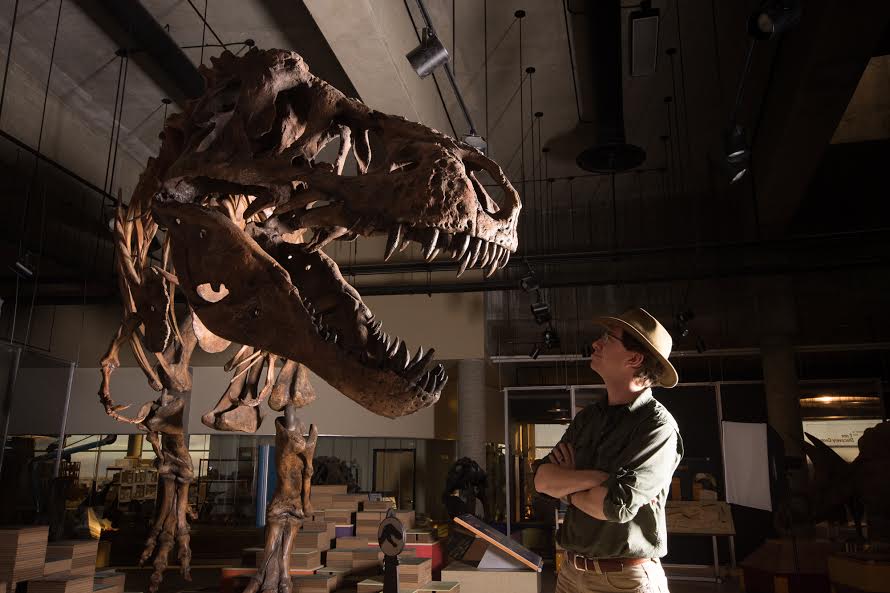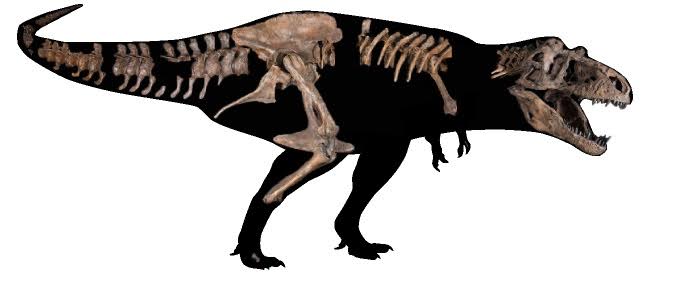Paleontologists Identify the World's Largest Tyrannosaurus Rex
Meet "Scotty," which at 8,870 kilograms (19,400 pounds), is the largest Tyrannosaurus rex ever unearthed.
Scotty is the "rex of the rexes," according to University of Alberta paleontologist Scott Persons, the lead author of a new study about the specimen published in The Anatomical Record.
"This the largest [T-Rex] as far as body proportions go," Persons said in a phone call with Motherboard. "Some individual tyrannosaurs, like human beings, tend to be tall or long or lanky while others tend to be more robust and thicker. It's the thicker individuals that are ultimately more massive."
"It's a bit like comparing a basketball player to a pro football player," he added. "Our animal is definitely in the robust football player category."
Scotty had likely entered its 30s when it died some 66 million years ago, which makes it older than any other known T-Rex. But though it lived to an advanced age, Scotty was no stranger to injuries; the fossilized bones show it suffered broken ribs, an infected jaw, and a possible bite from a rival tyrannosaur on its tail.
"Tyrannosaurs were not long-lived dinosaurs by any means," Persons said. "These are animals that grew fast and died fairly young." Based on known T-rex fossils, tyrannosaurs that made it to adulthood lived to be between 20 and 30 years old.
 Persons with cast of "Scotty." Image: Scott Persons
Persons with cast of "Scotty." Image: Scott Persons Scotty's remains were first discovered in 1991 in Saskatchewan, Canada, by a team that included Canadian paleontology luminary Phil Currie. Currie, who is also based at the University of Alberta, is a co-author on the paper, along with Florida State University paleontologist Gregory M. Erickson, who determined Scotty's age.
The dinosaur is nicknamed after the celebratory bottle of Scotch whiskey that was imbibed after the crew found the fossils (its official name is RSM P2523.8).
The rock that the dinosaur was preserved in was particularly hard, which is why a new millennium had arrived by the time Scotty was removed from its sandstone tomb.
Another decade passed before the T-rex's body proportions and age were determined.
"The way that we estimate that Scotty is larger is based on various proportions of the skeleton," Persons explained. "The girth of the femur, the upper leg bone, the width of the shoulder, the surface area of some of the back vertebrae-all of those indicate a particularly stout, massive tyrannosaur."
Scotty likely weighed about 400 kilograms more than Sue the T-Rex, the largest T-Rex before Scotty was discovered, currently housed at the Field Museum in Chicago.
 The surviving fossils of "Scotty." Image: Scott Persons
The surviving fossils of "Scotty." Image: Scott Persons That said, Sue remains the most complete known T-Rex, with nearly all of its body parts recovered. Scotty, by contrast, is just over 60 percent complete. (Despite the gendered names, it is not known whether Sue or Scotty were male or female tyrannosaurs.)
In addition to providing an upper limit on the T-Rex scale, Scotty could yield insights about other dinosaur species. Most dinosaurs are only known from a few scant fossils, leaving paleontologists with little information about the range of their sizes and ages. Scotty's record-breaking heft and lifespan provide a "data point at one extreme," Persons said, and that may be replicated for other dinosaurs in future discoveries.
Read More:Tyrannosaur Snouts May Have Been More Sensitive Than Human Fingertips
"Scotty suggests that as time goes on, all the other dinosaurs that we know of are probably going to increase as far as the range of maximum body size," Persons told Motherboard.
For the time being, though, the team is just happy to be able to release such long-anticipated details about the colossal dinosaur. "It's extremely exciting," Persons said. "It's an incredible thing to hold some of the bones of Scotty in your hands."
Scotty will be featured in an upcoming exhibit at the Royal Saskatchewan Museum in May 2019.
Get six of our favorite Motherboard stories every dayby signing up for our newsletter.